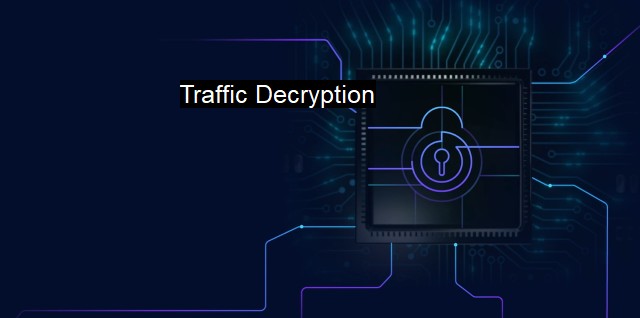What is Traffic Decryption?
Securing Digital Traffic: The Critical Role of Traffic Decryption and Antivirus in Cybersecurity
Traffic decryption is a crucial aspect of cybersecurity, primarily used to uncover and neutralize potential threats concealed within encrypted data. As we continue to evolve digitally, more and more information is encrypted to ensure its security during transmission over an increasingly vulnerable cyberspace. there's a different side to this security feature; cyber antagonists can hide malicious content within encrypted data, which is where traffic decryption steps in to solve the problem.The term "traffic decryption" refers to the process by which encrypted data or traffic is decrypted for analysis or inspection. it is a critical technique used by various security systems, including antivirus programs, to inspect the data packets traveling across a network. Under normal conditions, such data packets could be hidden behind layers of encryption, rendering them inaccessible to security tools. By decrypting the traffic, analysts can delve into the content of these data packets and gauge their potential implications on the network's security.
There's no denying it; encryption plays an essential role in safeguarding sensitive data over the internet. Encryption protocols such as SSL/TLS provide security by ensuring data integrity and confidentiality between a source and its intended destination. this does pose a challenge to security administrators. Because while encryption is designed to prevent unwanted intrusion, protecting the data from threat appears as a double-edged sword because cybercriminals can also leverage the same secure channels to deliver their malwares undetected. Thus, traffic decryption becomes a continuing necessity in cybersecurity.
Encrypted traffic that cannot be scrutinized by security solutions represents a significant blind spot in the network security architecture. Attackers can exploit this vulnerability to smuggle malware or exfiltrate confidential data out of a network. Security devices that can handle encrypted traffic in a non-decryptive mode have a limited view of the data - they work on metadata without actually examining the content inside. As a result, any malware hidden in the encrypted payloads is allowed to pass-through unhindered.
The traffic decryption process aims to mitigate this issue. Traffic decryption solutions, often incorporated within next-generation firewalls (NGFWs) or secure web gateways (SWGs), can intercept encrypted traffic and convert it into a readable format that other security equipment can scan in detail. Once decrypted, security tools can scrutinize the data for any threats like intrusions, malwares, spywares etc.
Traffic decryption tools utilize the principles of a "Man-In-The-Middle (MitM)" attack but in a legitimate, well-intentioned manner. These tools sit between client and server, intercepting and decrypting encrypted transmissions before analyzing them for threats. After examination, the data is encrypted again and sent along to the intended recipient without raising any red flags. In this regard, the flow of data remains as intended although with an additional 'stop’ for the security check-up.
Notably, traffic decryption has raised privacy concerns. Intercepting potentially sensitive user data and decrypting it for analysis subjects it to potential misuse, intentional or otherwise. This necessitates a balanced and responsible approach to traffic decryption. Organizations must institute robust data handling and privacy policies, especially for personally identifiable information (PII).
To address privacy issues, many traffic decryption solutions are designed to ignore SSL sessions to specific user-specified websites and categories. For instance, banking and healthcare-related websites are typically avoided from decryption due to the highly sensitive nature of the data involved.
Traffic decryption is a necessary part of the cybersecurity infrastructure. It facilitates sophisticated visibility into encrypted traffic to detect threats and protect an organization's network. as necessary as it is, traffic decryption must be responsibly practiced to maintain user trust and adhere to data privacy regulations.

Traffic Decryption FAQs
What is traffic decryption in the context of cybersecurity?
Traffic decryption refers to the process of intercepting and decoding network traffic in order to understand its content. This is often done for security purposes, such as detecting and preventing attacks, or for monitoring activities on a network.How is traffic decryption used in antivirus software?
In antivirus software, traffic decryption can be used to analyze network traffic and identify malicious activity or signatures. This can help detect and block malware before it can infect a system.Is traffic decryption legal?
The legality of traffic decryption depends on the laws and regulations in a particular jurisdiction. In some cases, it may be legal with appropriate authorization, such as a warrant or court order. In other cases, it may be illegal without consent or when it violates privacy rights.What are some potential risks or concerns with traffic decryption?
Some potential risks or concerns with traffic decryption include violating privacy rights, exposing sensitive information, and creating vulnerabilities in network security. Additionally, an incorrect interpretation of decrypted traffic could lead to false positives or negatives, and result in ineffective security measures.| | A | | | B | | | C | | | D | | | E | | | F | | | G | | | H | | | I | | | J | | | K | | | L | | | M | |
| | N | | | O | | | P | | | Q | | | R | | | S | | | T | | | U | | | V | | | W | | | X | | | Y | | | Z | |
| | 1 | | | 2 | | | 3 | | | 4 | | | 7 | | | 8 | | |||||||